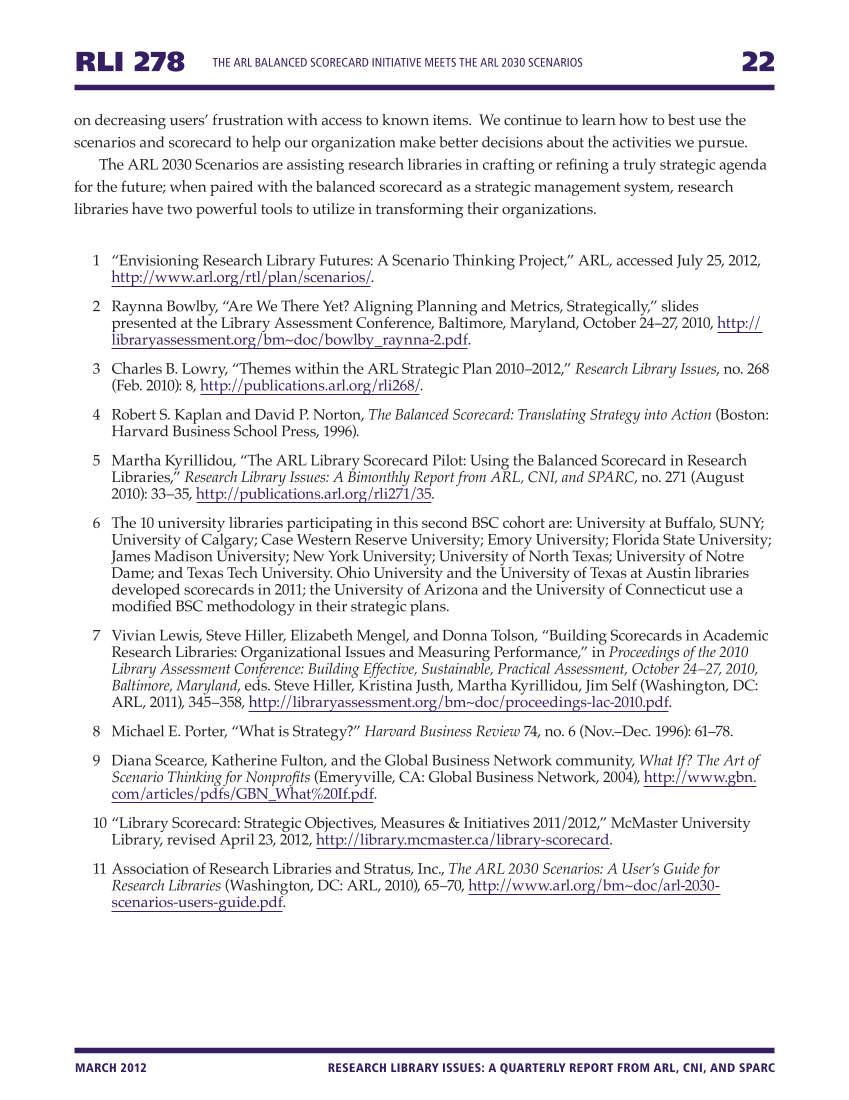RLI 278 22 March 2012R esearch Library Issues: A Quarterly Report from ARL, CNI, and SPARCarc The ARL Balanced Scorecard Initiative Meets the ARL 2030 Scenarios on decreasing users’ frustration with access to known items. We continue to learn how to best use the scenarios and scorecard to help our organization make better decisions about the activities we pursue. The ARL 2030 Scenarios are assisting research libraries in crafting or refining a truly strategic agenda for the future when paired with the balanced scorecard as a strategic management system, research libraries have two powerful tools to utilize in transforming their organizations. 1 “Envisioning Research Library Futures: A Scenario Thinking Project,” ARL, accessed July 25, 2012, http://www.arl.org/rtl/plan/scenarios/. 2 Raynna Bowlby, “Are We There Yet? Aligning Planning and Metrics, Strategically,” slides presented at the Library Assessment Conference, Baltimore, Maryland, October 24–27, 2010, http:// libraryassessment.org/bm~doc/bowlby_raynna-2.pdf. 3 Charles B. Lowry, “Themes within the ARL Strategic Plan 2010–2012,” Research Library Issues, no. 268 (Feb. 2010): 8, http://publications.arl.org/rli268/. 4 Robert S. Kaplan and David P. Norton, The Balanced Scorecard: Translating Strategy into Action (Boston: Harvard Business School Press, 1996). 5 Martha Kyrillidou, “The ARL Library Scorecard Pilot: Using the Balanced Scorecard in Research Libraries,” Research Library Issues: A Bimonthly Report from ARL, CNI, and SPARC, no. 271 (August 2010): 33–35, http://publications.arl.org/rli271/35. 6 The 10 university libraries participating in this second BSC cohort are: University at Buffalo, SUNY University of Calgary Case Western Reserve University Emory University Florida State University James Madison University New York University University of North Texas University of Notre Dame and Texas Tech University. Ohio University and the University of Texas at Austin libraries developed scorecards in 2011 the University of Arizona and the University of Connecticut use a modified BSC methodology in their strategic plans. 7 Vivian Lewis, Steve Hiller, Elizabeth Mengel, and Donna Tolson, “Building Scorecards in Academic Research Libraries: Organizational Issues and Measuring Performance,” in Proceedings of the 2010 Library Assessment Conference: Building Effective, Sustainable, Practical Assessment, October 24–27, 2010, Baltimore, Maryland, eds. Steve Hiller, Kristina Justh, Martha Kyrillidou, Jim Self (Washington, DC: ARL, 2011), 345–358, http://libraryassessment.org/bm~doc/proceedings-lac-2010.pdf. 8 Michael E. Porter, “What is Strategy?” Harvard Business Review 74, no. 6 (Nov.–Dec. 1996): 61–78. 9 Diana Scearce, Katherine Fulton, and the Global Business Network community, What If? The Art of Scenario Thinking for Nonprofits (Emeryville, CA: Global Business Network, 2004), http://www.gbn. com/articles/pdfs/GBN_What%20If.pdf. 10 “Library Scorecard: Strategic Objectives, Measures & Initiatives 2011/2012,” McMaster University Library, revised April 23, 2012, http://library.mcmaster.ca/library-scorecard. 11 Association of Research Libraries and Stratus, Inc., The ARL 2030 Scenarios: A User’s Guide for Research Libraries (Washington, DC: ARL, 2010), 65–70, http://www.arl.org/bm~doc/arl-2030- scenarios-users-guide.pdf.
























